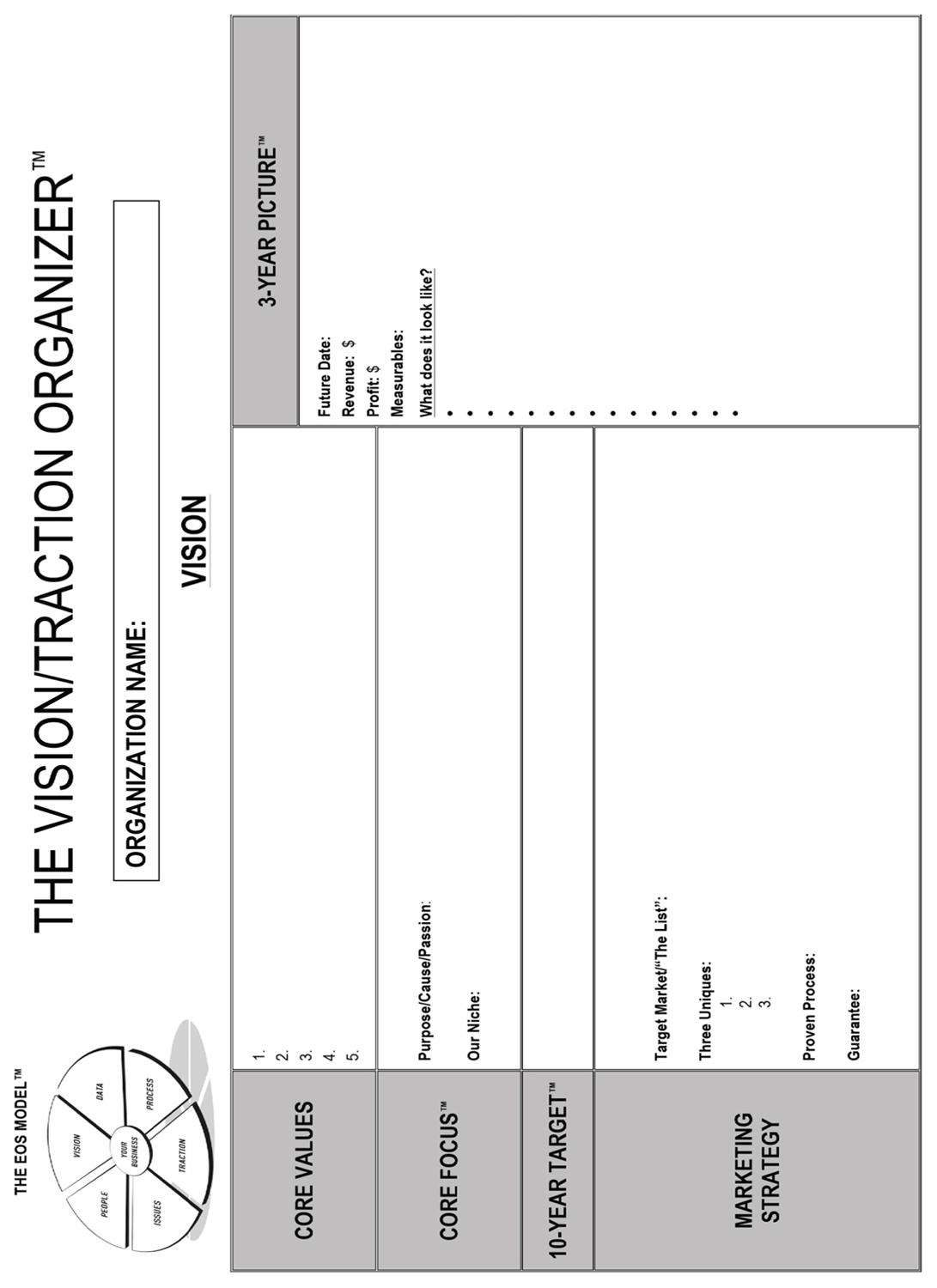
I always thought management didn’t know where we were going. If they did, they sure weren’t sharing it with me. The V/TO changed that.
—LINDSEY CLEMENT, accounting and HR specialist, Proximity Systems, Inc.
Great companies have leaders who communicate a crystal-clear Vision to the entire company. A company’s Vision, simply put, is a matter of defining who you are, where you are going, and how you will get there.
Do you know your company’s Vision for the future? Every company has one, but it might not be written down or shared with everyone. Perhaps only a few leaders carry it around in their heads.
A worse problem is when a leadership team thinks they all agree on the same Vision and they really don’t. If they don’t agree with one another on the same Vision, they and the company will end up rowing in different directions. In addition, when the Vision is not written down, it is difficult for a leadership team to know if they are on the same page—not to mention sharing it with everyone else in the company. This leads to poor communication, confusion, and wasted effort.
As an example, the leadership team members of a New England telecom firm were asked to write down the company’s top priorities for the next year. Not a single answer was the same. One person thought that sales were the top priority while another thought it was hiring additional operations people. Yet another manager thought it was opening an office on the West Coast. Clearly, they were rowing in different directions and communicating different priorities to the employees.
The EOS tool that helps your leadership team define, document, agree on, and share the company Vision is called the Vision/Traction Organizer or “V/TO.” The V/TO is illustrated on the next two pages.
The V/TO aligns your leadership team around the answers to 8 essential questions about your business. Those questions are shown in the 8 shaded sections in the V/TO. Once your leadership team answers each question, the answers are captured in the appropriate section.
The V/TO helps the team get their vision out of their heads and down on paper so it can be shared with the whole company. Once everyone throughout the organization shares the same vision, they can row in the same direction. They can now “see” where they are going.
Have you ever tried to navigate in a new city without your GPS device or phone? If so, you probably had a good map so you wouldn’t get lost. A clearly defined vision shared by everyone in the company is like having that map. It helps you see where you’ve been, where you are, and where you are going. The result is a stronger company, which leads to more job security and opportunities for employees.
Now that you understand why getting everyone on the same page with your company’s Vision is so important, we’ll next take you through a deeper dive into each of the 8 questions on the V/TO:
1. What are your Core Values?
2. What is your Core Focus?
3. What is your 10-Year Target?
4. What is your Marketing Strategy?
5. What is your 3-Year Picture?
6. What is your 1-Year Plan?
7. What are your Rocks?
8. What are your Issues?
We’ll now briefly explain why each question is important to you and how each question helps your business unite around its Vision.
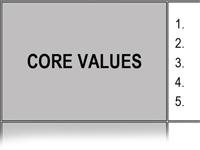
Core Values are a timeless set of guiding principles. There are typically just a few—3 to 7 is the rule of thumb. They define the behaviors you expect from each other. They define your culture and who fits and who doesn’t. They define what makes your company different and unique.
A famous business guru, Peter Drucker, is attributed with the saying, “Culture eats strategy for breakfast.” History has shown that culture wins in the long run, not strategy. For a company to be great, it must first know who it is. Then focus on strategy. Who you are as a company is defined by your Core Values.
Every company has different Core Values because, well, every company is different. To help build a strong culture, your company will use your Core Values to hire, fire, and review everyone (how this happens will be detailed in Chapter 8).
Here is an example of the EOS Worldwide Core Values (keep in mind yours will be different):
1. Humbly Confident
2. Grow or Die
3. Help First
4. Do What You Say
5. Do the Right Thing
Let’s take one of those, “Do What You Say,” as an example. In a “Do What You Say” culture, everyone delivers on time. That means if you commit to a date, you hit it. You fully deliver and finish what you start—doing things half-assed or half-finished is unacceptable. Everyone takes responsibility, owns their projects, and blames no one if something doesn’t get finished. Finally, in a “Do What You Say” culture, it is okay to say no—if you can’t do it, don’t commit.
Your leadership team has worked very hard to discover what your company’s Core Values are in order to build an amazing culture. Once these Values are shared, we urge you to ask questions in order to fully understand them. Ultimately you have to ask yourself, “Do I share these Core Values?”
You’ll find that when you work with people who share the same Core Values, communication is easier, things get done faster, and the work environment is more fun. You will have a great organization and a strong culture.

Whereas Core Values define who you are as an organization, Core Focus defines what you are. Core Focus is about keeping your company and all of its people focused on the areas where your business excels.
It is very easy for businesses to get distracted by “shiny stuff”—things that look like the right thing to do but are really not in the sweet spot of what you do as an organization.
A furniture manufacturer in Wisconsin, for example, spent so much money on advertising each year that they decided to save money by opening their own advertising agency. They spent a significant amount of time and money starting up this division. Unfortunately, in the end, they lost hundreds of thousands of dollars and had to close down the operation. Why? It was not what they did best. Their sweet spot was manufacturing furniture.
Lisa Fisher at United Paint made a comment regarding the power of Core Focus: “Before EOS, we attempted to be everything to everyone, from paint for office furniture to paint for plastic toys in McDonald’s Happy Meals. Honestly, if it was a current customer who had a nonautomotive job or a really shiny opportunity, we tried it. After EOS, we were able to get to one Core Focus—automotive interior coatings for plastic. Shiny stuff is now just not even considered.”
Core Focus keeps companies from getting distracted. It comes from the intersection of knowing why your company exists and what you do in the world.
Your why is known as a Purpose, Cause, or Passion. It is an overriding belief that is bigger than a goal, and it makes you want to get out of bed every day. Your what is known as a Niche. It defines the space in which you do business; it identifies what you do better than anyone else. Once these 2 truths are clarified and put together, you have your Core Focus.

Here are some examples to help you better understand Core Focus:
MARKET TRADERS—teaches people how to successfully trade foreign currency
Purpose: Changing lives through empowerment
Niche: Trading and investment education
NEXUS HEALTH—runs post-surgery hospitals
Cause: Returning patients to lives of productivity and meaning
Niche: Specialty health care
TEL AID—helps companies implement large system and IT projects
Passion: Making the complex simple and repeatable
Niche: Large IT projects
Once you know your company’s Core Focus, you’ll realize that you are part of something bigger than yourself. Hopefully, this will be inspiring. In addition, your Core Focus serves as a filter that allows your organization to say no to good ideas and yes to great ones. As a result, all effort, people, systems, processes, and even products will be designed and aligned to keep you true to what you do best and propel you toward your vision.

Now that you know who you are and what you are as an organization, you need to determine where you are going. The 10-Year Target is your long-term, larger-than-life goal. It unites everyone around one common objective. In many cases, it helps you and your company achieve goals you never thought possible.
Imagine a sailboat without a rudder. It just goes wherever the wind blows it. Many companies are like this—they don’t have a long-term target. They don’t know where they are going.
Why is the 10-Year Target important? As Yogi Berra said, “If you don’t know where you’re going, you’ll end up someplace else.” In other words, if you know where you want to go, you have a much better chance of getting there.
In addition, working toward a long-range goal can create more opportunities for employees like you. Finally, it gets everyone asking the right questions, like: What does our company need to start doing differently to reach our 10-Year Target? What do we need to change? What could we do better?
These examples will help you better understand the 10-Year Target:
With a clear 10-Year Target that is shared by all, you will have a guiding light by which everyone can steer. This focus will direct your energy, resources, and decisions to help you grow faster and reach your 10-Year Target more quickly.
As with the above examples, most 10-Year Targets involve rapid and significant growth, which can’t happen without the right Marketing Strategy—and that leads us to the next question on the V/TO.
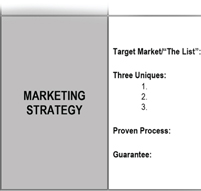
Defining your Marketing Strategy requires crystallizing who your ideal customer is and clarifying the most appealing message to them. Doing this will create a laser-like focus for your sales and marketing efforts. This in turn will help increase your sales and move you toward your 10-Year Target.
You’ve probably had to deal with a customer who is a pain in the butt. They call your service department multiple times a day for the wrong reasons. They submit special orders that fall outside your standard process. You fix computers, and they want you to fix their desks.
Many companies waste thousands of dollars trying to be everything to everyone. They waste money with inconsistent marketing messages. They take sales trips to prospective customers who are never going to say yes or are not a good fit for the company. They commit to projects in which they have no expertise.
The Marketing Strategy will help you stay focused, selling to customers who are the most receptive and take less organizational time to service. It will help align your organization around the real, unique value you provide the customer.
Your Marketing Strategy is made up of 4 key elements:
1. Target Market
2. 3 Uniques
3. Proven Process
4. Guarantee
Let’s take them one at a time.
The Target Market identifies the characteristics of your best customers (who they are, where they are, and how they think). Once your Target Market is identified, your company can focus more energy toward those ideal customers and less toward others who don’t fit or who generate less profit. Here is an example of a Target Market:
• $5–$50 million in revenue
• 20–250 employees
• Southeastern United States
• Growth-oriented
• Seeking a partner, not a commodity provider
The 3 Uniques describe the 3 things that make you better than the competition and why your customers buy from your company. For example, they could be the following:
• 99% on-time delivery
• Local technicians
• 24-hour response time
The Proven Process is a visual of what you do, time and time again, to deliver value to your customer over the life of the relationship. It creates a picture of what your customers will experience when they work with you. Here is the EOS Proven Process:
Your Guarantee is designed to take away your customers’ biggest fear when it is time for them to buy. It says that you stand behind your product or service. This is where you put your money where your mouth is. Here are 3 different examples that companies have used:
• We will hit our ship date, or we will pay for your shipping.
• If we don’t add value, you don’t pay.
• We will show up on time, or the first hour is free.
These 4 elements make up your Marketing Strategy. Once implemented, you will focus on customers who are easier and more enjoyable to do business with. Your 3 Uniques will provide a consistent message for all of your sales and marketing efforts. You will differentiate yourself and put your clients’ minds at ease with your Proven Process and your guarantee. All of these will help increase your sales and put you on track to hit your 10-Year Target faster.
The next step in achieving your Vision is painting a picture of what your company will look like in 3 short years. The 3-Year Picture creates a vivid image of exactly what your company will look like, feel like, and be like in 3 years.
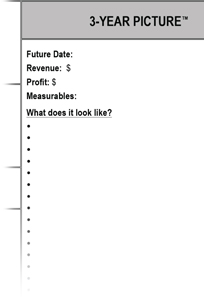
Unfortunately, a lot of managers don’t share their picture of the future with employees. Why not? Most of the time, they don’t know it themselves—or at least haven’t written it down.
The 3-Year Picture helps everyone see the same image 3 years down the road. It contains just a handful of numbers: Revenue, Profit, and a Measurable. In addition, it contains 5 to 15 bullets that “paint” the picture for you. Here is an example of a company’s 3-Year Picture:
Date: 12/31/20XX
Revenue: $14.5 million
Profit: $1.8 million
Measurable: 300 customers
What does it look like?
• 80 employees
• 3 new product lines
• 100% Right People in the Right Seats
• Bright, energetic, fun office
• Strong culture
• Largest customer accounts for <10% of revenue
• Best place to work in the state
• All Core Processes documented and Followed By All
The 3-Year Picture allows your leadership team to paint a powerful picture of the future so you can see what they are saying. Once everyone sees this Vision, it is more likely to happen. It’s important that you ask questions once this is rolled out. By challenging anything that isn’t clear, you will ultimately understand the big picture and then decide if you want to be a part of it.
Once clear, it will give you the context in which to set goals for the next 12 months. Which leads us to the next question.

This is where we start to take the Vision down to the ground. A solid 1-Year Plan makes the goals more tangible. Simply put, your 1-Year Plan defines your objectives for the year. It identifies and crystallizes your revenue target, profit target, and a Measurable, along with your top 3 to 7 goals for the year.
Why only 3 to 7 goals? Because fewer is better and less is more. When companies try to get too many things done, they lose focus and, as a result, accomplish very few of them. With too many goals, organizations spread resources across too many priorities and then fall short.
One company in New Jersey drew up 15 priorities for the year. “We tried to get all of them done, but in reality we accomplished very little,” stated the CEO. “We just spread our people too thin. Now we pick 3–7 goals for the year and have been very successful at accomplishing most of them. It’s one reason our sales increased 18% this past year.”
Once your 1-Year Plan is clear, you’ll know exactly what you need to accomplish over the next 12 months to put you on a path to reach your 3-Year Picture and ultimately achieve your 10-Year Target. All energy and resources will be focused on your selected few goals, propelling your company forward and providing you with a greater chance of success.
Here is an example of a company’s 1-Year Plan:
Date: 12/31/20XX
Revenue: $8 million
Measurable: 150 customers
Goals:
1. Sign deals with 2 premier vendors
2. 100% Right People in the Right Seats
3. Add 3 salespeople to the current team of 7
4. All Core Processes documented
5. Add 50 new customers
Hopefully, you see the pattern, from the 10-Year Target to the 3-Year Picture down to the 1-Year Plan, which helps everyone know what’s most important in the coming year. And that will create the clarity necessary to set your quarterly Rocks.
Rocks are the 3 to 7 most important objectives the company must get done in the next 90 days in order to achieve your 1-Year Plan.
Why 90 days? In most cases, companies start the year with good intentions, but then life gets in the way. In January and February, everyone is energetic and focused on the priorities, but then people start getting distracted by competitors’ actions, unplanned emergencies, and day-to-day distractions.
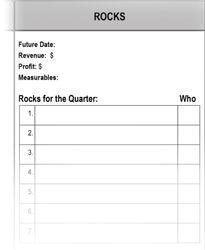
As a result, that great energy is lost, and plans start to unravel and fray. Deadlines get pushed back, and priorities get lost in the hustle and bustle. All of a sudden, November rolls around, and you’re saying, “Oh crap! How are we going to get this all done?”
Rocks help solve this problem by breaking down annual goals into bite-size chunks. This approach is illustrated in the following story:
On January 14, 2015, Tommy Caldwell and Kevin Jorgeson finished one of the most difficult climbs in the world—the sheer southeastern face of El Capitan in Yosemite National Park. They spent 19 days scaling the almost 3,000-foot, never-before-free-climbed vertical wall. When asked how they did it, Jorgeson said, “We’ve been working on each of these stages and climbing ‘pitches.’ [We broke them] up by rope lengths. Our ropes are about 200 feet long, so the pitches are obviously 200 feet long or less.”
In other words, they climbed the 3,000-foot face 200 feet at a time. To reach their overall goal, they broke it down into smaller, manageable chunks by setting short-term goals along the way.
Another benefit of Rocks is that they create a 90-Day World for your organization that addresses an important aspect of human nature—human beings tend to lose focus, get off track, and fray about 90 days into any project. Rocks get everyone refocused right on the 90th day as the unraveling begins, avoiding the coming fray and maximizing everyone’s efforts and energy.
Here are some examples of company Rocks:
Date: 3/31/20XX
Revenue: $2 million
Profit: $200,000
Measurable: 115 customers
1. Fill one sales position
2. Software version 2.3 in production
3. Go/no-go decision made on new office
4. Purchase 4 trucks
By setting Rocks every quarter, your company will get a lot more done in a lot less time. Every 90 days, your company will refocus and set new Rocks. With that done, everyone will know the most important priorities for the company every 90 days.

The final question is as important as the previous 7. To achieve your company’s Vision, it is vital to openly admit all of your company’s obstacles to the opportunities that lie before you. This is simply a list of all the things that could prevent your company from reaching your Vision or that will help you get there faster.
All organizations have issues. The problem is that, in many companies, no one admits them, or when they do, everyone just talks about them but does nothing. As a result, it feels as if there are hundreds of problems that are never resolved.
At the furniture manufacturer in Wisconsin who false-started with the ad agency, employees were asked to list the issues they saw. The following is an actual conversation:
EMPLOYEE: There’s a hole in the roof of our warehouse.
CEO: So how big of an issue is it?
EMPLOYEE: Every time it rains or snows, water drips on the furniture, and we have to throw the furniture out.
CEO: How much money did that cost us last year?
EMPLOYEE: About $250,000.
CEO: That’s 20% of our profit!
EMPLOYEE: Yeah, we’ve been talking about it for a year.
Putting all of the issues on one list will help your company get a handle on them. And remember: in addition to problems, issues are also ideas and opportunities. You might have an idea on how to grow the company faster. That idea must be added to the Issues List too.
Once the issues are out in the open, the EOS tools in the following chapters will help you to prioritize and solve them. Once your issues are listed, your company can start to prioritize and work them one at a time—resolving them forever. The first step is admitting them.
So now you know the 8 questions that make up the V/TO. You should have a good idea of what each means and why they are important. When completed, your organization’s V/TO will look similar to the example on the next two pages.
If you haven’t seen your company’s V/TO yet, your leadership team will probably be sharing it with you soon. Please note that some companies roll the V/TO out to employees all at once and others roll it out one piece at a time—either way is fine. Also, you can ask your manager if your company’s V/TO is ready to be shared with you.
Once your leadership team answers the 8 questions and your V/TO is complete, documented, and shared with the entire company, you’ll have a crystal-clear picture of who you are, what you are, and where you are going as an organization. You’ll ultimately have a great company filled with great people who fit your Core Values. Your Core Focus will serve as a filtering and guiding mechanism for deciding on people, products, customers, and processes.
All effort will be aligned toward achieving your 10-Year Target. Your Marketing Strategy will focus your sales efforts on the right clients with the right message. Everyone will see, buy into, and work toward the 3-Year Picture.
Shorter term, all energy will be focused on achieving a handful of goals for the year. Your 1-Year Plan will be broken down into Rocks that will create a very focused and productive 90-Day World. Finally, all company issues will be placed openly and honestly on the Issues List, so you can pick them off by prioritizing and solving them, one at a time.
With this clarity, everyone will be rowing in the same direction. You will be part of an incredibly focused organization with a strong culture.
Sarah McNulty, account manager at Limbach, stated, “We all have a clear idea of what the future goals and Vision are for the company, which helps us remember that our daily activities are focused on a much bigger, future picture. It allows us to realign our activities when necessary to keep us on track.”
Here’s a summary of each of the 8 questions on the V/TO and what each answers for your company:

Your role is to understand and believe in your company’s Vision (answers to these 8 questions) and to align all your efforts toward helping achieve that Vision. You can’t do that without asking questions, so to help you do that, discuss the following 3 questions with your manager.

1. How can our department help achieve the company Vision?
2. What role do I play in achieving the Vision?
3. What is our greatest challenge in achieving our Vision?